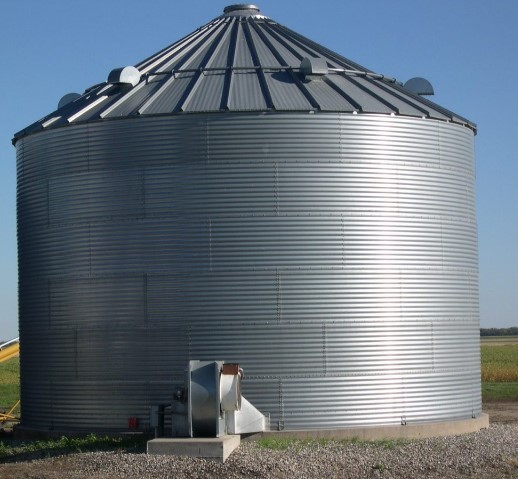By Kenneth Hellevang
The drastic outdoor cooling that has occurred may create some grain storage and drying problems. Dr. Ken Hellevang, Extension Engineer at North Dakota State University, answers several questions that he received in the paragraphs below. The questions are italicized and his answers immediately follow.
“With the sudden change in air temps, what is the best management strategy for running aeration fans on bins to cool grain without freezing the bin?”
The kernels will not freeze together if the corn moisture content is below 24%. There is extensive experience with cooling corn to well below freezing and the corn still being able to flow normally. The acceptable moisture content decreases with more foreign material in the corn. I recommend that corn moisture be less than 24% to hold it until outdoor temperatures are above freezing and at or below 21% to hold corn until spring.
Some people are recommending that wet corn be not be cooled below freezing because ice crystals will form in the void spaces between the corn with the moisture coming from the corn. I am not aware of this being a problem again based on extensive experience.

Frosting will occur when moist air comes in contact with a surface at a temperature below freezing. It typically occurs when air from warm corn comes in contact with a cold bin roof and roof vent during aeration. It can occur with corn at temperatures below freezing when warmer air comes through the cold corn. This could occur if the corn at the top of the bin was cold and warm air from corn below is moved through the cold corn as the bin is cooled using aeration. Normally this will occur only in a shallow layer of corn at the top of the bin and only for a period of time until that corn has been warmed by the warm aeration air coming from the warm corn. The amount of frost accumulation expected in the corn increases as the corn gets colder and layer of corn gets thicker. Since corn is a good insulator, the cold layer is normally expected to be fairly thin and the warm aeration air removes the frost.
If the corn is warmer than the bin steel, condensation in the form of frost will occur on the bin roof and bin vents. The rapid drop in outdoor temperature makes this very likely. Cooling the corn in small steps reduces this potential. The general goal is to cool the corn to just below freezing, so operate the fans only when outdoor air temperature is above 20 degrees. Corn at 22 percent moisture has an estimated allowable storage life of about 60 days at 40 degrees and 30 days at 50 degrees. Cool corn at recommended moisture contents can wait for cooling until appropriate temperatures exist. Ideally the aeration air temperature would be 10 to 15 degrees cooler than the corn. If it is extremely cold, it is best to not run the fan and wait for an appropriate air temperature.
“Should I place cold grain on warm grain?”
Placing warm grain on cold grain will increase the potential for condensation and frosting in the cold grain. The grain in the bin should be cooled before cold grain is placed on top. Review the explanation of the conditions that may lead to frosting within the corn. Placing cold grain on top of warm grain creates the conditions expected to cause frosting problems. The amount of frost is not normally enough to restrict or block airflow. The frozen mass could increase the force required to break the ice, so normal stirring devices may not be adequate. It may require using another method of breaking the corn apart to permit unloading.
“Does grain harvested at air temps below freezing create special concerns?”
Corn harvested at temperatures below freezing can be placed into storage, but should not be placed on top of warmer corn. The maximum recommended moisture content is about 23 percent to reduce the potential for kernels freezing together. If corn at 25% moisture is placed into a bin with kernel temperatures below freezing, it should flow out of the bin as long as the kernels do not warm above freezing. At 25% moisture there may be enough surface moisture to cause the kernels to stick (freeze) together if they are warmed and then cooled below freezing.
“How should I manage the following three scenarios?”
1. Grain harvested at 15% moisture with air temps at 60 to 70 degrees F, filled bin day before cold air moved in: When is the best time to run the fan and how long can I wait to start cooling the bin?
The allowable storage time of 15% corn at 70 degrees is about 125 days, so there is time to select the appropriate temperature to aerate the grain. As described earlier, there will be extensive frosting on the bin roof if the aeration fan is operated when outside temperature is below freezing and there will be extensive condensation if there is a large temperature difference between the corn and outside temperature with the outside temperature above freezing. As much as possible, select a time to aerate the corn when outside temperature is 40 to 50 degrees to cool the corn. This may be accomplished by waiting for warmer weather and running the fan during the daytime. If warmer weather is not expected, then run the fan when outside air temperature is near or just above freezing. Leave the fill and access doors open to minimize the potential for bin vents freezing over and the fan pressure damaging the bin roof. Be aware that frost or condensation will likely occur and may be extensive. Monitor the bin and corn closely and manage moisture accumulation.
Click here to see more...